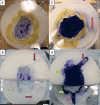Science supporting negative pressure wound therapy with instillation
- PMID: 24251840
- PMCID: PMC7950798
- DOI: 10.1111/iwj.12171
Science supporting negative pressure wound therapy with instillation
Abstract
A new method (V.A.C.ULTA Therapy System, KCI USA, Inc., San Antonio, TX) combines the benefits of negative pressure wound therapy (NPWT; V.A.C. Therapy, KCI USA, Inc.) with regulated, periodic instillation of user-selected topical wound solutions (V.A.C. VeraFlo Therapy, KCI USA, Inc.). In simulated wound model studies comparing solution distribution using NPWT with and without a soak phase, the instillation soak phase allowed for uniform solution distribution across the wound bed, whereas continuous (no soak) irrigation resulted in uneven coverage. Additional in vitro work illustrated that bacterial particle aerosolisation during wound cleansing was significantly decreased using NPWT with instillation (NPWTi) versus commercially available low-pressure wound cleansers (P < 0·05). In porcine studies, NPWT with saline instillation induced 43% more granulation tissue versus NPWT (P < 0·05) and was as effective at wound cleansing as pulsed lavage. These studies have demonstrated that NPWTi may be an effective wound management therapy that provides both wound cleansing and NPWT benefits.
Keywords: Negative pressure wound therapy; Negative pressure wound therapy with instillation; Periodic instillation; Reticulated open-cell foam; Wound cleansing.
© 2013 The Authors. International Wound Journal © 2013 John Wiley & Sons Ltd and Medicalhelplines.com Inc.
Figures






Similar articles
-
Simplified negative pressure wound therapy with instillation: advances and recommendations.Plast Surg Nurs. 2014 Apr-Jun;34(2):88-92. doi: 10.1097/PSN.0000000000000033. Plast Surg Nurs. 2014. PMID: 24887351
-
Use of Negative-Pressure Wound Therapy With Instillation and Dwell Time: An Overview.Plast Reconstr Surg. 2021 Jan 1;147(1S-1):16S-26S. doi: 10.1097/PRS.0000000000007607. Plast Reconstr Surg. 2021. PMID: 33347059 Review.
-
A comparative study of negative pressure wound therapy with and without instillation of saline on wound healing.J Wound Care. 2016 Aug;25(8):475-8. doi: 10.12968/jowc.2016.25.8.475. J Wound Care. 2016. PMID: 27523660
-
Clinical recommendations and practical guide for negative pressure wound therapy with instillation.Int Wound J. 2016 Apr;13(2):159-74. doi: 10.1111/iwj.12452. Epub 2015 May 23. Int Wound J. 2016. PMID: 26011379 Free PMC article. Review.
-
New advances in instillation therapy in wounds at risk for compromised healing.Surg Technol Int. 2014 Mar;24:75-81. Surg Technol Int. 2014. PMID: 24700215 Review.
Cited by
-
A Case Review of Necrotizing Soft Tissue Infection of the Abdomen Utilizing Negative Pressure Wound Therapy with Instillation and Novel Reticulated Open Cell Foam Dressing.Cureus. 2018 Oct 26;10(10):e3497. doi: 10.7759/cureus.3497. Cureus. 2018. PMID: 30613452 Free PMC article.
-
Negative pressure wound therapy with intermittent irrigation for treatment of post-traumatic giant abscess: A case report.Int J Surg Case Rep. 2022 May;94:107068. doi: 10.1016/j.ijscr.2022.107068. Epub 2022 Apr 11. Int J Surg Case Rep. 2022. PMID: 35427892 Free PMC article.
-
Combination of Girdlestone Pseudoarthroplasty and Negative Pressure Wound Therapy with Instillation and Dwell in the Treatment of Invasive Osteomyelitis of the Proximal Femur.Cureus. 2018 Nov 6;10(11):e3552. doi: 10.7759/cureus.3552. Cureus. 2018. PMID: 30648084 Free PMC article.
-
Application and influence of four drain configurations on fluid dispersal and retrieval in a cadaveric canine wound infusion-retrieval system model.Vet Surg. 2025 Feb;54(2):398-409. doi: 10.1111/vsu.14191. Epub 2024 Nov 20. Vet Surg. 2025. PMID: 39568136 Free PMC article.
-
Utilizing the VeraFlo™ Instillation Negative Pressure Wound Therapy System with Advanced Care for a Case Study.Cureus. 2016 Nov 30;8(11):e903. doi: 10.7759/cureus.903. Cureus. 2016. PMID: 28070472 Free PMC article.
References
-
- Argenta LC, Morykwas MJ. Vacuum‐assisted closure: a new method for wound control and treatment: clinical experience. Ann Plast Surg 1997;38:563–76. - PubMed
-
- Banwell PE, Teot L. Topical negative pressure (TNP): the evolution of a novel wound therapy. J Wound Care 2003;12:22–8. - PubMed
-
- Fleischmann W, Russ M, Westhauser A, Stampehl M. Vacuum sealing as carrier system for controlled local drug administration in wound infection. Unfalchirurg 1998;101:649–54[Article in German]. - PubMed
-
- Jerome D. Advances in negative pressure wound therapy: the VAC instill. J Wound Ostomy Continence Nurs 2007;34:191–4. - PubMed
-
- Kaehn K, Eberlein T. In‐vitro test for comparing the efficacy of wound rinsing solutions. Br J Nurs 2009;18:S4–10. - PubMed
Publication types
MeSH terms
Substances
LinkOut - more resources
Full Text Sources
Other Literature Sources
Medical

